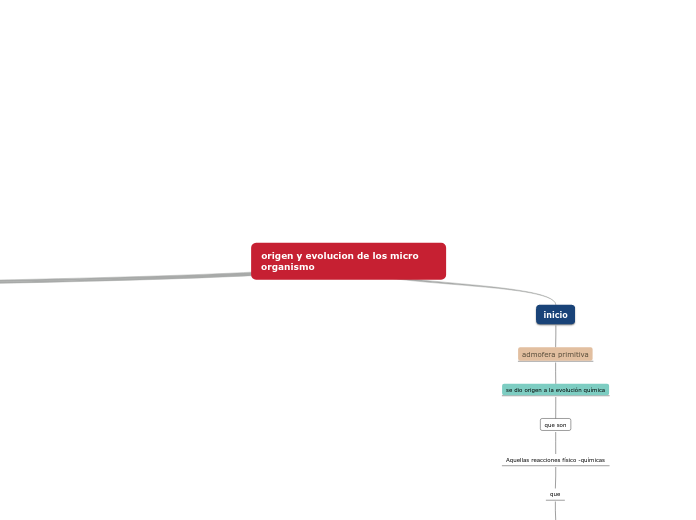によって haner rubio 5年前.
315
origen y evolucion de los micro organismo

によって haner rubio 5年前.
315

もっと見る
Type in the name of the multiple-perspectives text.
Example: Bridge to Terabithia by Katherine Paterson
Type in a relevant quote that highlights the character's point of view towards
inicio.
Try following a citation format: author's name, chapter, and page.
Example: 'Jesse drew the way some people drank whiskey. (...) Lord, he loved to draw. (...) When he was in first grade, he told his father that he wanted to be an artist when he grew up.' (Paterson, 2. 7)
que son
Aquellas reacciones físico -químicas
que
dieron origen a la vida
origino
la evolución biológica
habla
Sobre los primeros organismos unicelulares anaeróbicos que habitaron nuestro planeta
se habla de una simbiosis
que genero
ana erobicos
organismos aerobicos
Que reagrupa a los seres vivos en 3 grandes dominio que englobaria a los reinos
(2)taxonomía
se encarga de clasificar ordenadamente y jerárquicamente los seres vivos
identificacion
nomesclatura
taxones
con la aparición de estos organismos se implemento (1) la nomenclatura binomial(lineo)
nombre especifico
nombre cientifico
Por evolucion
eukarya
formado por celulas eucariotas
bacterias
también , estructuralmente mas evolucionas que las ar,cheas carecen de membrana , pared celular
tipos de bacterias
según la fuente de electrón y energía
según el tipo de nutrición
autotrofa ,eterotrofa
según la temperatura optima
termofilas , mesofila,sicrofilas
cocos, bacilos , etc
son celulas procariotas
que estas a su vez
son
celulas simples , mas pequeñas
archeas
se clasifica
korarcehaeota
son hipertemofilo
crenarchaeota
anaerobica, ambientes frios y entempraturas altas
euryarchaeota
halófilos, metanógenos
habita salinas y ambientes de alta temperatura
hancontrabuido para investigar hipótesis sobre las primeras formas de vida
son diferentes a las bacterias
Decide on the fourth point of view
Type in the name of the last character whose perspective on the issue you are going to present.
Example: Leslie Burke, Jesse's new next-door neighbor, and best friend.
Point of view
Type in a relevant quote that highlights the character's point of view. Try to follow a citation format: author's name, chapter, and page.
Example: I can't get the poetry of the trees,' he said. She nodded. Don't worry,' she said. You will someday. He believed her.' (Paterson, 4. 24)
How is the viewpoint introduced in the story?
Choose an answer:
Whose character does the third point of view belong to?
Type in his/her name.
Example: Mr. Aarons, Jesse's father.
What does the character think, say or do that suggests their perspective on the issue?
Type in a quote and try to maintain the citation format.
Example: 'He would like to show his drawings to his dad, but he didn't dare. (...) He'd thought his dad would be pleased. He wasn't. What are they teaching in that damn school? he had asked.' (Paterson, 2.8)
What kind of narration introduces the viewpoint?
Choose an answer:
Type in a quote that points out the character's position about the issue.
Try to follow a citation format: author's name, chapter, and page.
Example: 'She said he was unusually talented, and she hoped he wouldn't let anything discourage him.' (Paterson, 2. 8)
How is the viewpoint introduced in the story?
Choose an answer:
Type in a relevant quote that highlights the character's point of view towards
Issue.
Try following a citation format: author's name, chapter, and page.
Example: 'Jesse drew the way some people drank whiskey. (...) Lord, he loved to draw. (...) When he was in first grade, he told his father that he wanted to be an artist when he grew up.' (Paterson, 2. 7)
Type of narration
What type of narration introduces the viewpoint?
Choose an answer:
Identify an important issue from the text that is being presented from different angles. Type it in.
Example: Jesse's drawing talent.
Decide on the second point of view
Name the character (it can either be the main character or one of the supporting characters) whose point of view you are presenting.
Example: Miss Edmunds, Jesse's music teacher.
Decide on the first point of view you are going to present.
Type in the name of the character (it can either be the main character or one of the supporting characters) whose point of view belongs to.
Example: Jesse Oliver Aarons, Jr., the main character of the novel, a fifth-grader living in a rural Southern area.